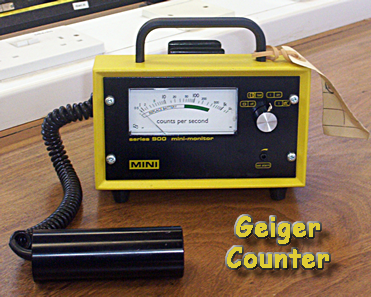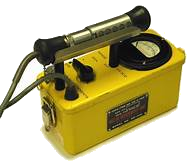Geiger Counters
Geiger counters are instruments thatdetect and measure ionizing radiation, as emitted by radioactive sources. The heart of a geiger counter is the Geiger-Mueller Tube. Geiger-Mueller TubeThis is a gas filled tube, to which a voltage of several 100V is applied. Normally, no current is drawn as the gas does not conduct electricity. When a radiation particle passes the tube, it triggers a 'gas discharge', that is to say, the gas is ionised and the charged particles conduct a current. The current impulse can be amplified and made visible or hearable ("clicking"). There are two main kinds of tubes: Glass tubes are only suitable for looking at beta and gamma rays, as any alphas would be absorbed by the glass and not reach the gas. They can be used for quantitatively measuring gamma dose-rate. Window tubes have a window (usually at one end), which is sealed with a very thin foil or mica. Some of the alpha particles can penetrate this window, and be detected, as well as betas and gammas. As the window is very thin, it is easily punctured. Window tubes are therefore more expensive and less common than glass tube ones but are necessary to detect alpha particles.
When a charged particle or gamma-radiation enters the tube, through the thin mica window, the inert gas becomes ionized. This triggers a whole avalanche of ions between the electrodes. For a brief moment, the gas conducts and a pulse of current flows in the circuit. The counter - either a scaler or a ratemeter - counts the pulses. A scaler counts the pulses and shows the total on a visual display. A ratemeter indicates the number of pulses or counts per second. The whole ensemble is often called a 'Geiger counter' (Poor Muller often gets forgotten!).
For each experiment the Geiger counter should be calibrated against a known radiation source. The calibration insures that your measurements are correct and your Geiger counter is working properly. Once calibrated you should be careful not to adjust the settings.
|
Follow me...
|








